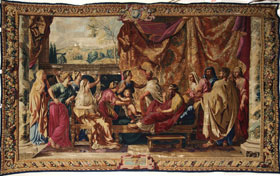The infant Moses trampling the crown of the Pharaoh

Moïse foulant la couronne
collection du Mobilier national
© I.Bideau
You are now in front of the tapestry titled the Infant Moses trampling the crown of the Pharaoh.
Here you can look at Nicolas Poussin’s painting, painted in 1647 side by side with the tapestry reproducing this theme. It was transcribed onto a cartoon by the painter Pierre de Sève and woven at the Gobelins tapestry works by the workshop of Jean Jans (pronounce YANS, in the Dutch way) the Younger in 1685.
Here is the story that is taking place before your eyes, according to the text by historian Flavius Josephus.
Moses is saved from the waters by the Pharaoh’s daughter. One day she brings Moses, still a young child, to her father. She announces to him that she is contemplating making Moses her son and the heir of the kingdom. She puts the child into the arms of Pharaoh, who places his crown on Moses’ head. But Moses throws the crown to the floor and tramples on it. On seeing this, the high priest recognises the child as the one who will bring about the fall of Egyptian power and rushes to kill him.
Poussin sets this scene in the semidarkness of the palace, in front of some imposing hangings. A group of men, on the right, stands behind Pharaoh who is reclining on a bed. On the left the ladies-in-waiting surround the Pharaoh’s daughter, seated opposite her father. The action takes place in the centre: the priest, dagger raised, is on the point of striking Moses. Two women save the child in the nick of time, one holding back the enraged priest, the other seizing hold of the child.
The differences in treatment between the painting and tapestry are apparent. A landscape has been created in the upper left of the tapestry while the scene in the painting takes place behind closed doors. Similarly, the yellow drapery of the background, untranslatable to the tapestry, has become a curtain of heavy folds, with a complex ornamental design and many variations of colour. It is no longer a background wall, but a very strong feature of the composition..
To take the comparison further, you can listen to some selected extracts from the texts of
